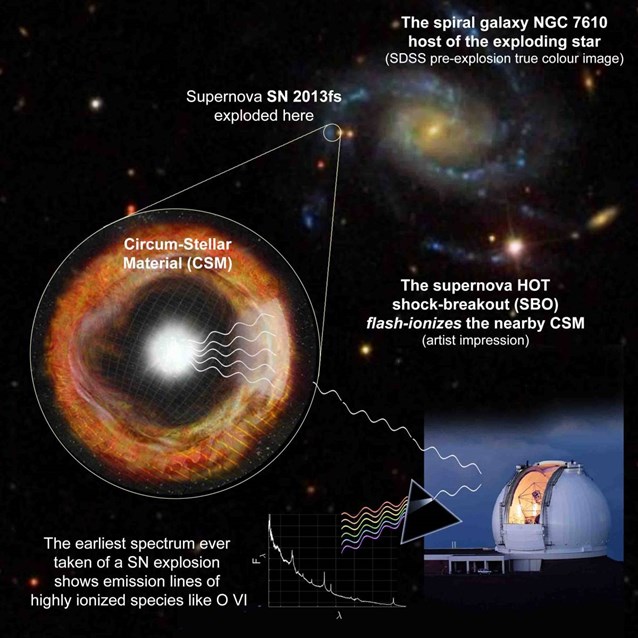
This graphic shows galaxy NGC 7610 (top right), where the supernova SN2013fs exploded. The event was detected by the Palomar Transient Factory sky survey (bottom right) a mere 3 hours after explosion. The detection was so rapid that researchers could image the circumstellar material (middle left) that surrounded the exploded star. (Ofer Yaron)
It was a type II supernova, the kind that occurs when a massive star evolves into a red supergiant, like the star Betelgeuse. In their waning days, these huge, (relatively) cool bodies start to unravel, expelling huge amounts of their mass until they are surrounded by shells of dense gas called circumstellar material, or CSM.
In the past, it’s been difficult to study the CSM, because it gets swept away by ejecta (stellar shrapnel) once the star blows up. But the spectra taken by Yaron, Perley and their colleagues captured this gas shell before it vanished.
By analyzing the wavelengths of light that came from the CSM, scientists can begin to figure out its chemical composition, how dense it is, how quickly the matter accumulates — questions they could never answer before. They can also start to understand the instability of stars in the months and weeks before they go supernova — possibly allowing scientists to predict when stars are going to blow.
“Several years ago if you found a supernova after about a week or so from explosion, that would be regarded as a very early detection,” Yaron said. “Now we are in the area of Day One supernova detection and science. But we want to go down to the hours and maybe even the minute scale.”
This year, the iPTF project, of which Yaron is a part, will give way to the Zwicky Transient Factory. This initiative will operate at the same telescope as its predecessor, but it will use a camera with a much wider field of view, allowing it to photograph more of the sky more often. This survey will be more than an order of magnitude faster than iPTF, according to Yaron.
Even better is the proposed UltraSat mission, an as-yet-unfunded space telescope that would study the sky in the near ultraviolet end of the spectrum. Its field of view would be nearly 30 times bigger than that of the iPTF camera, enabling it to return to the same patch of sky several times a night and allowing for even more rapid detection of “transients” — celestial phenomena like supernovae that flash for a moment, then fade.
“If we can really catch things during the first minutes of the event, and then our follow-up observations across the whole electromagnetic spectrum … that opens up a completely new window to exploration of the transient sky,” Yaron said.
